- Rule, Britannia, no more?
- Unpopular Opinions: US Quadball Cup 2023
- Proven Contenders: University of Virginia
- Proven Contenders: Rutgers University
- Proven Contenders: University of Michigan
- Proven Contenders: Creighton University
- Different Perspectives: A Look Inside USA Ultimate
- Antwerp QC, Much of Belgian Core, Leaves Competitive Quidditch
Weekly Water Cooler: Shedding Some Tiers
- By Dan Hanson
- Updated: October 23, 2014
I want to take my opportunity on the podium of The Eighth Man’s Weekly Water Cooler to rave about the up-in-the-air craziness that has been this season. A lot more controversy than gameplay has been discussed coming out of last weekend, which is a shame, because there were some really interesting results. Today, let us address the gameplay craziness compared to seasons past rather than the off-the-pitch debacles.
Up until World Cup VII, quidditch was shockingly predictable, especially considering the variable nature of the sport with very brief games and a 30-point play that ends games. With strange score lines and shocking upsets popping up all over the place since April, hasn’t everything felt very different as a quidditch fan?
World Cup VI may end up being the most sensible World Cup of all time. While many results were shocking and fascinating in that moment, in retrospect, they all made a lot of sense. No. 17 Bowling Green State University rallied around their strengths. No. 5 University of Maryland struggled to finish off teams in close, intense games. No. 6 University of Miami’s lack of depth brought them down on day two. No. 9 Marquette University proved that they came into the tournament very overrated. The most shocking result to this day is No. 2 University of Texas 200* – No. 1 Texas A&M University 40, but even that makes sense considering how Texas proved themselves to be in a league of their own.
Back then, Texas and UCLA, along with Baylor University, A&M and Boston University in their own right, were model programs whose greatness elevated the game, making the clearest and proudest Tier One in the game’s history. The storyline of a Tier One continued until World Cup VII, although some of the characters changed, but World Cup VII was insane. The laundry list of surprises and and upsets is still puzzling. In pool play alone, Macaulay Honors College beat Texas State University; Utah Crimson Fliers beat University of Miami; Harvard University beat Maryland; University of Kansas led Texas A&M at the time of the catch; and University of Virginia beat Bowling Green before an appeal overturned the result. Then on Sunday, LSU beat Lost Boys and Kansas nearly toppled Lone Star Quidditch Club in overtime. On paper, those results are inconceivable. Those are matchups where an underdog by even more than a single tier proved they could hang, while conventional wisdom at the time said that there were no more than a dozen teams in relevant tiers. The world seemed like it was falling apart when Texas State burst out of the gate to take a 40-10 lead on Texas. Unfortunately for Texas State, the defending World Champions Texas answered with a 90-10 run followed by an in-range catch. When the trophy was delivered, the world was left trying to make some semblance of sense of what had just taken place.
The trend set by World Cup VII is still going strong, and perhaps it is time for analysts to stop our efforts to group teams into tiers as often as we have in the past, as Ethan Sturm discussed last week. Our analysts are more experienced and more knowledgeable than we have been in the past and video is more prevalent than ever, yet, I do not believe that our ability to produce accurate rankings has gotten any better. Teams outside The Eighth Man Top 20 could easily beat a top-ten team any given week. New York University showed it by leading Maryland at the time of the snitch grab at Oktoberfest and Arkansas showed it by flipping the script with a win against Kansas at Cowboy Cup.
This makes week-to-week tournaments and the upcoming regional championships incredibly exciting, more so than such tournaments ever have been before! However, there is one tournament that I think will suffer, and that is World Cup VIII. Maybe I am stuck in the old ways, but I loved the days of World Cup VI when everything seemed to unfold in a definitive way where the results showed where teams stood at the end of the season. World Cup VII was exciting, but the best quidditch game of that tournament took place in the Elite Eight when Texas A&M beat Lone Star 100*-70. The semifinals were each, in their own way, a failure to display what games between four great quidditch teams should look like. On one field we saw a stoppage- and penalty-riddled slugfest between A&M and Texas and on the other, we saw Texas State outlast an exhausted Emerson College squad. World Cup VI was not perfect (UCLA v. Baylor was the best-played World Cup semifinal ever), but we should expect to see improvement in the excitement of gameplay rather than a recession.
With the amount of parity in the league this year, I can only imagine more chaos in the bracket. With three straight World Cups featuring the majority of the top-five contenders crowding on the same side of the bracket, this year could be even worse. It is feasible that games that could or should be the final will take place as early as the Sweet 16. The pressure on refs and snitches is higher than ever, as there is a great deal more opportunities for small mistakes by officials to swing the course of history. Pool-play seedings are more important than ever, as Pools of Death and Pools of Life could skew the bracket even more than in the past.
My point is not that this is an overall bad thing; it is worth the weekly excitement that every tournament is displaying. Quidditch’s regular season feels more important than ever. But I have always been a huge supporter of the 80-team World Cup, and I might be coming around. I love the idea of the biggest possible tournament, but perhaps someday sooner rather than later, our national champion should be decided in a more exclusive tournament featuring a selection committee or additional series of playoff-style qualification. In an ideal world, teams would have the means to travel one more time to a 24- or 32-team tournament to ultimately decide the season’s champion. Maybe someday another program will rise to the level of the legendary teams of the World Cup VI era. But for now, let us enjoy the ride and the sheer excitement that this season will bring.
CRAY-STONE CUP
Keystone Cup looked like an interesting field and it did not disappoint. Who would you have considered the favorite going in? Bowling Green came in slightly higher ranked at No. 15 to No. 18 Ball State University and the No. 19 The Warriors. University of North Carolina also received Top-20 votes. Bowling Green was the only team who had posted decisive results, coming off a decisive 160*-40 win against Ball State in their most recent tournament final on Ball State’s home turf. A few key pieces were missing such as Chad Brown from Bowling Green and Trevor Campbell from Ball State, while the Warriors were boasting their most complete roster thus far. University of Richmond and Villanova were out to prove that UNC wasn’t a lock to face Maryland in the Mid-Atlantic Regional Championship finals. NYU was the final team to be added to the tournament, a team that has existed since 2010 but has always danced at the edge of relevance to the upper levels of quidditch. QC Pittsburgh has been consistently trending down since back-to-back World Cup Final Four appearances in 2009 and 2010.
Anybody who predicted an NYU v. Ball State final is lying. Campbell has been a hot topic and has responded by consistently sandbagging himself, and his team showed it can stand on its own by handling Bowling Green without him. Ball State seems to back up their high ranking every time they play in spite of many saying they are overrated. Their standout player has to be Jason Bowling, who looks like Ball State took their former stud seeker Tyler Macy and stretched him out to be a foot taller. Bowling has been having a stellar season, with an 80*-70 loss against Miami University of Ohio the only questionable mark on his record. He has been especially effective catching snitch after snitch in bracket play, racking up team victories when his chasers are down in quaffle points. He has now beaten Team USA’s Sam Roitblat twice this season and now has a win against The Warriors’ newest addition Andrew Zagelbaum under his belt.
NYU looks like they are having their strongest season ever with snitch-range losses against Tufts University and Maryland at Oktoberfest and a Keystone finals appearance preceded by a strong showing in pool play. The only game at Keystone that they finished trailing in quaffle points was a 180*-80 loss at the hands of their local competition, The Warriors. This team is for real and might have an even more impressive showing at the Northeast Regional Championship than last year, when they surprised QC Boston: the Massacre to end up in the Final Four. While they have showed major improvement as a team, they look similar on offense to the NYU of two season ago. Zack Gindes is the new John Gaffigan, sinking long shots and orchestrating a strong offense alongside chaser/beater hybrid Kyle Jeon and beater Dylan Meehan.
UNC had a disappointing tournament, going 3-3. They failed to catch snitches in those losses, which makes their now famous lack of defense an even more concerning weakness. Luckily for them, Bowling Green stole the show in terms of disappointment. They could not take advantage of a Warriors team down four players to cards late in the game, and they wasted possession after possession against Ball State. I doubt you even need to guess how the latter took place: missed long shots. Missing pieces or not, Bowling Green is showing fundamental flaws in their strategy. Ball State did not look like a tournament champion themselves in beating Bowling Green, but they made fewer mistakes. Three weeks remain until the Midwest Regional Championship, where both of these teams will have to improve to show their early season success was not a fluke.
Keystone Cup might be a microcosm of this season: lots of close games and surprising results to go along with far fewer elite teams than we have seen in past seasons. Major props to Jack McGovern for adding tournament director to his already impressive quidditch resume.
WILD WILD WEST
The West has gotten some flack for such a slow start to the year, with Lumberjack Invitational being only the second interstate tournament so far this year.
Northern Arizona University came away as the champions, which was largely overshadowed by the official status of the tournament put in jeopardy by an unofficial final. However, unofficial or not, NAU proved a lot. Whether you want to consider their finals win over Arizona Quidditch Club, they beat the brand new community team 150*-90 in pool play. And when I say brand new, I mean brand new. AZQC did not practice together until just before the tournament.
It is a shame we did not get to see NAU face the LA Gambits, as they are clearly an improved team since their debut at Crimson Cup. They flipped an out of range loss to the Crimson Elite to an 80*-50 win. Having Porter Marsh back at seeker certainly helped, but their beater game is what is outmatching the competition. They look like they have an outside shot of stealing the West Regional Championship if they can keep this rate of development through the snowy Flagstaff winter.
The biggest on-field question people are asking: Is AZQC for real? They had a crazy 140*-110 victory over the Gambits, where they received seven yellow cards, two each going to two of their best quaffle players, Ethan Kapke and Duncan Lewis. Tony Rodriguez got carded out on the other side after only six and a half minutes, begging the question of whether the Gambits would have run away with Rodriguez commanding the pitch. Instead, world champion seeker and brand new Southern California resident Margo Aleman was able to make the catch in a tie game. AZQC will likely develop more in their tournaments than in practices, given the spread out location of their players. Along with Aleman, beater Amanda Nagy will also be a tournament-only player based out of SoCal. So by their nature and the huge question mark of their penalty-filled game, AZQC did not prove themselves to be a regional contender in their first tournament. Other teams will get the practice time to overtake them, and AZQC needs to prove they can avoid penalties in big games. Kapke, who was both a card draw and a spark plug during his time at Arizona State University, got double-yellowed out of two of their other games.
And then there is the Gambits, undoubtedly the most interesting team in the West. They brought another short roster, but this time they had the benefit of featuring Ren Bettendorf in addition to Andrew Murray and Rodriguez. This tournament proved that they are not invincible, but they are still the team to beat in the West.
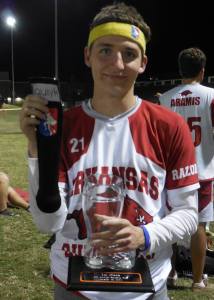
Credit: Eric Dreggors
MORE PARITY IN THE GREAT PLAINS
University of Arkansas has had a roller coaster of a year. They came into it ranked No. 15 and were labeled overrated. They were soon all but wiped off the rankings, receiving a mere five points after decisive losses to No. 13 Kansas and University of Minnesota and a 10-point win against University of Missouri. Well, clearly, they became underrated, as they caught snitches in tie games to beat Oklahoma State University in the semifinals and Kansas in the finals.
Unfortunately for them, their performance may have picked up a little too much hype, as they skyrocketed from five to 95 points in our poll, giving them the best ranking in their history at No. 11. The jump may be a little much, and we should soon find them overrated once more. Not that they couldn’t beat all the teams ranked below them, and a few above them, but we need to see more than just one hard-fought tournament after an underwhelming Kansas Cup.
Arkansas seeker Eric Dreggors is now riding his own personal hype train, thanks to a five for five snitch catch performance with three games in range at the tournament in which he averaged 28 seconds to make a catch. Is Dreggors for real? Absolutely! This is the first time I have ever heard a time attached to a SWIM record, a huge stat. Granted, there are plenty of other factors that come into play: seeker beating, snitch skill, etc. But a 28-second average in five wins is impressive no matter which way you cut it. Let us see how he takes his skills into the next tournament, which may not be until the Southwest Regional Championship.
Missouri is putting forth their best team ever, showing a level of driving ability that they never have before. They kept their biggest rival Kansas close for a major chunk of yet another marathon game and held Oklahoma State to snitch range. Missouri and Oklahoma State are both teams that are hovering not far outside of the Top 20, although they get very little national attention. One of the most interesting storylines at the Midwest Regional Championship will be seeing how the Great Plains teams compare to the Great Lakes teams.
WAIT, HOW MANY TOURNAMENTS WERE THERE LAST WEEKEND?!
It was by far the busiest weekend of the season. Martin Pyne recorded 138 official games at nine tournaments and still has another handful of games to enter.
Preseason Midwest favorites Ohio State were the Phoenix of Phoenix Cup, with a surprising 130*^-100 overtime loss to an apparently very improved Blue Mountain Quidditch Club. They were able to dominate in the rematch 150*-30, showcasing more depth than the community team. But watch out for Blue Mountain, they have improved the most so far this season.
Boston University is back! Jon Goc took the field for the team for the first time this season and proved to be a game changer as BU jumped back on the national radar in a three-game series with Emerson, winning 110*-70 and then losing a close 140^-120 match before Emerson took the series with a 160*-70 win.
Next week, the Northeast refuses to slow down while the weather is bearable as Boston finally plays host to a major tournament. NYU will be there to try to follow up their solid Keystone Cup performance. Tufts will take the field with their first tournament win in their school’s history just two weekends behind them. Massacre, RIT and Emerson will look to prove their team is the one to beat in the upcoming Northeast Regional Championship, while BU aims to prove it still deserves the Northeast throne.
But the most-anticipated tournament of this season has to be Wolf Pack Classic. The opportunity to watch the Southwest’s Big Five in action would be enough, but Miami will also be making an appearance to show how the South measures up.
This is it—the last big tournament weekend, and then we will officially enter regional championship season.
About Dan Hanson
Dan started playing quidditch for Emerson College in 2009 and moved to Los Angeles in 2011, where he played for the Lost Boys and founded the Southern California Quidditch Conference. He now lives in quidditch purgatory, where he plays for the Utah Crimson Fliers. Dan officially hit Twitter fame when he live-tweeted Global Games despite a poor Wi-Fi connection and being in Canada. His interests include baseball, board games, television and trying to have his hand in everything quidditch-related. #thechart

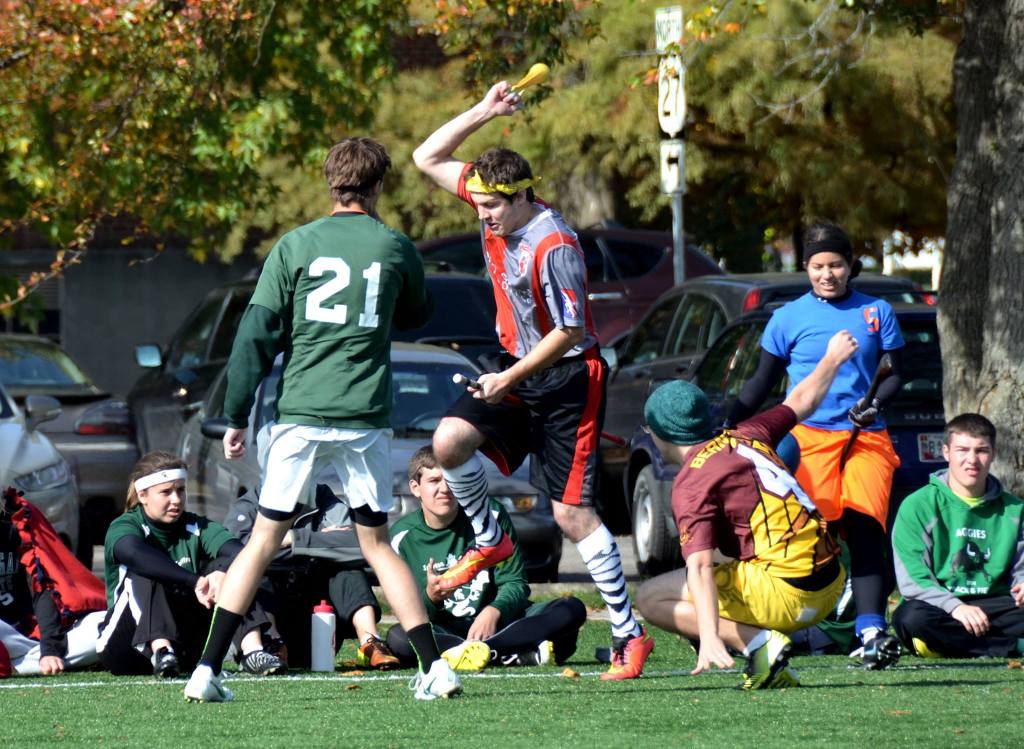
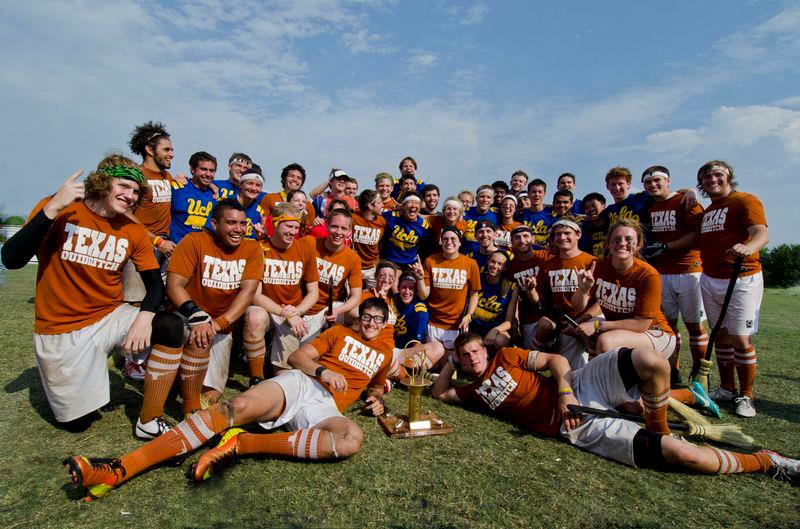
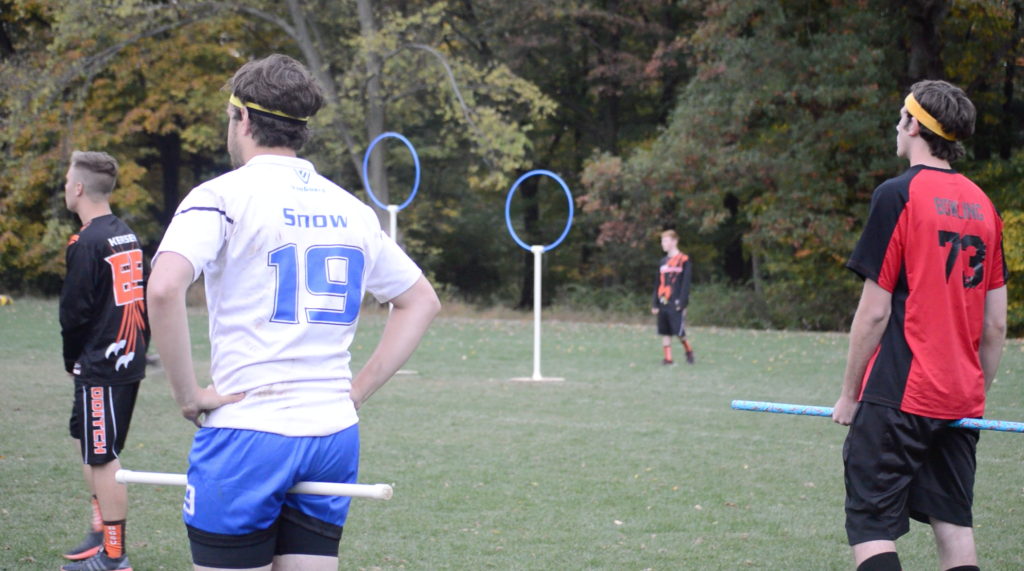
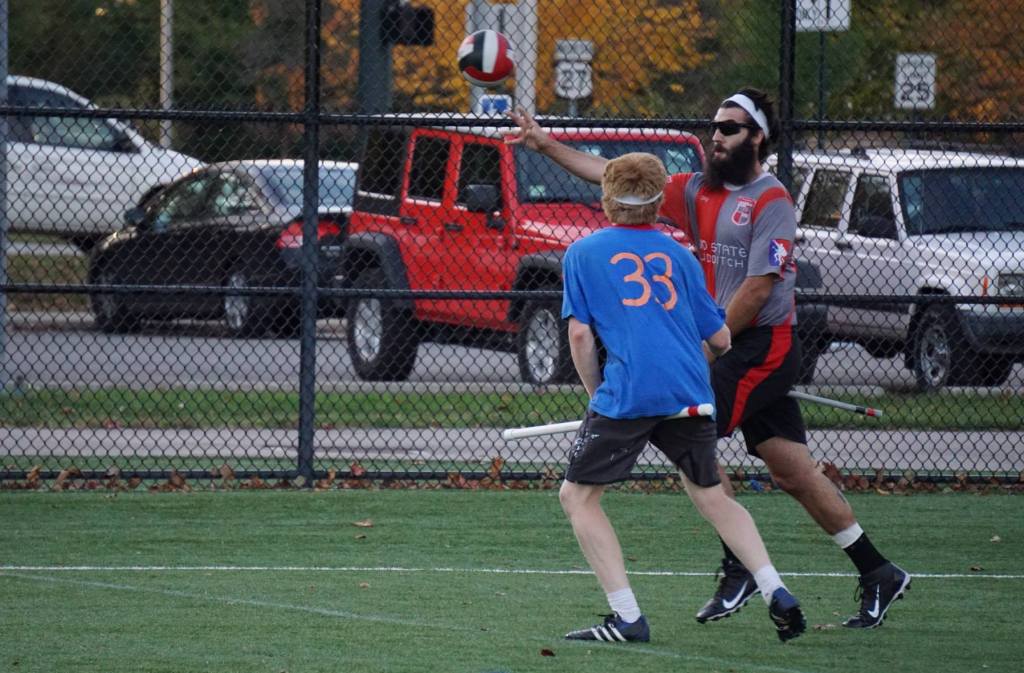
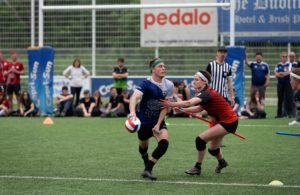

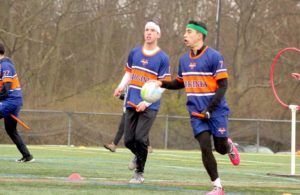
2 Comments